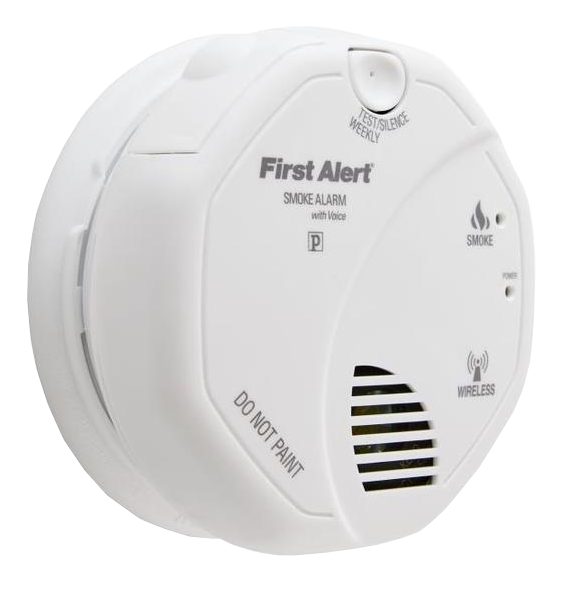|

Smoke Alarms and Detectors
Smoke detectors are devices that automatically sound a warning when they sense smoke or other products of combustion. They are usually mounted on a wall or the ceiling. When people are warned early enough about a fire, they can escape before it spreads. You can purchase one starting at $6.
Every year house fires kill thousands. Fire kills an estimated 4,000 Americans every year. Another 30,000 people are seriously injured by fire each year. Property damage from fire costs us at least $11.2 billion yearly. Most fire victims feel that fire would "never happen to them.
Although we like to feel safe at home, about two-thirds of our nation's fire deaths happen in the victim's own home. The home is where we are at the greatest risk and where we must take the most precautions. Most deaths occur from inhaling smoke or poisonous gases, not from the flames.
Most fatal fires occur in residential buildings between 11 p.m. and 6 a.m. when occupants are most likely asleep. Over 90 percent of fire deaths in buildings occur in residential dwellings.
A Johns Hopkins University study, funded by the United States Fire Administration, found that 75 percent of residential fire deaths and 84 percent of residential fire injuries could have been prevented by smoke detectors.
There are two basic types of smoke detectors:
- Ionization detectors - Ionization detectors contain radioactive material that ionizes the air, making an electrical path. When smoke enters, the smoke molecules attach themselves to the ions. The change in electric current flow triggers the alarm. The radioactive material is called americium. It's a radioactive metallic element produced by bombardment of plutonium with high energy neutrons. The amount is very small and not harmful.
- Photo-electric detectors - This type of detector contains a light source (usually a bulb) and a photocell, which is activated by light. Light from the bulb reflects off the smoke particles and is directed towards the photocell. The photocell then is activated to trigger the alarm.
Choosing a smoke detector
When choosing a smoke detector, there are several things to consider. Think about which areas of the house you want to protect, where fire would be most dangerous, how many you will need, etc.
The National Fire Protection Agency recommends that every home have a smoke detector outside each sleeping area (inside as well if members of the household sleep with the door closed) and on every level of the home, including the basement. The National Fire Alarm code requires a smoke detector inside each sleeping area for new construction. On floors without bedrooms, detectors should be installed in or near living areas, such as dens, living rooms or family rooms. Smoke detectors are not recommended for kitchens.
Installation
The placement of smoke detectors is very important. Sleeping areas need the most protection. One detector in a short hallway outside the bedroom area is usually adequate. Hallways longer than 30 feet should have one at each end. For maximum protection, install a detector in each bedroom.
Be sure to keep the detector away from fireplaces and wood stoves to avoid false alarms. Place smoke detectors at the top of each stairwell and at the end of each long hallway. Smoke rises easily through stairwells. If you should put a smoke detector in your kitchen, be sure to keep it away from cooking fumes or smoking areas.
It’s important to properly mount a smoke detector. You can mount many detectors by yourself, however those connected to your household wiring should have their own separate circuit and be installed by a professional electrician. If you mount your detector on the ceiling, be sure to keep it at least 18 inches away from dead air space near walls and corners. If you mount it on the wall, place it six to 12 inches below the ceiling and away from corners. Keep them high because smoke rises.
Never place them any closer than three feet from an air register that might re-circulate smoke. Don't place them near doorways or windows where drafts could impair the detector operation. Don't place them on an un-insulated exterior wall or ceiling. Temperature extremes can affect the batteries.
Maintenance
It’s simple to keep smoke detectors in good condition. Always follow the manufacturer's instructions. Be sure to replace the batteries every year or as needed. Most models will make a chirping, popping or beeping sound when the battery is losing its charge. When this sound is heard, install a fresh battery, preferably an alkaline type.
Remember, every three years to change the bulbs. Keep extras handy. Check the smoke detector every month by releasing smoke or pushing the “test” button. Clean the detector face and grillwork often to remove dust and grease. Never paint a smoke detector as it will hamper its function. Check your detector if you've been away from home.
Smoke Detectors make great housewarming (or any time) gifts. It's an interesting present that can save lives and it shows that you care.
| 
